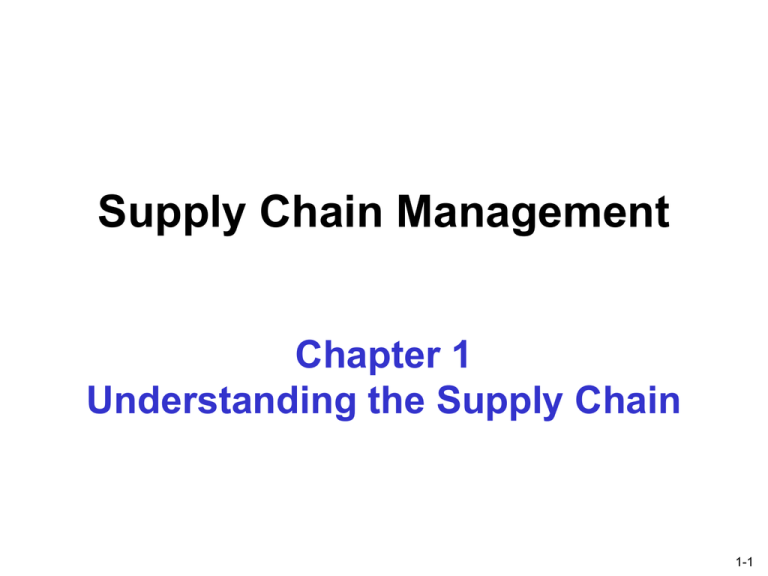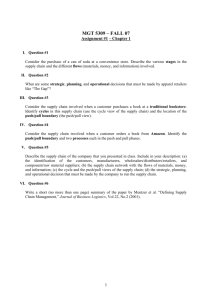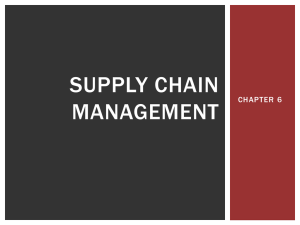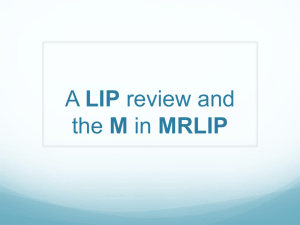Supply Chain Management Chapter 1 Understanding the Supply Chain 1-1
advertisement

Supply Chain Management Chapter 1 Understanding the Supply Chain 1-1 What is a Supply Chain? All stages involved, directly or indirectly, in fulfilling a customer request Includes manufacturers, suppliers, transporters, warehouses, retailers, and customers Within each company, the supply chain includes all functions involved in fulfilling a customer request (product development, marketing, operations, distribution, finance, customer service) 1-2 What is a Supply Chain? Customer is an integral part of the supply chain Includes movement of products from suppliers to manufacturers to distributors, but also includes movement of information, funds, and products in both directions Probably more accurate to use the term “supply network” or “supply web” Typical supply chain stages: customers, retailers, distributors, manufacturers, suppliers All stages may not be present in all supply chains (e.g., no retailer or distributor for Dell) 1-3 What is a Supply Chain? P&G or other manufacturer Migros or third party DC Plastic Producer Tenneco Packaging Chemical manufacturer (e.g. Oil Company) Paper Manufacturer Migros Supermarket Customer wants detergent and goes to Migros Chemical manufacturer (e.g. Oil Company) Timber Industry 1-4 Flows in a Supply Chain Information Product Customer Funds 1-5 The Objective of a Supply Chain Maximize overall value created Supply chain value: difference between what the final product is worth to the customer and the effort the supply chain expends in filling the customer’s request Value is correlated to supply chain profitability (difference between revenue generated from the customer and the overall cost across the supply chain) 1-6 The Objective of a Supply Chain Sources of supply chain revenue: the customer Sources of supply chain cost: flows of information, products, or funds between stages of the supply chain Supply chain management is the management of flows between and among supply chain stages to maximize total supply chain profitability 1-7 The Objective of a Supply Chain Example: Dell receives $2000 from a customer for a computer (revenue) Supply chain incurs costs (information, storage, transportation, components, assembly, etc.) Difference between $2000 and the sum of all of these costs is the supply chain profit Supply chain profitability is total profit to be shared across all stages of the supply chain Supply chain success should be measured by total supply chain profitability, not profits at an individual stage 1-8 Decision Phases of a Supply Chain Supply chain strategy or design Supply chain planning Supply chain operation 1-9 Supply Chain Strategy or Design Decisions about the structure of the supply chain and what processes each stage will perform Strategic supply chain decisions – – – – Locations and capacities of facilities Products to be made or stored at various locations Modes of transportation Information systems Supply chain design must support strategic objectives Supply chain design decisions are long-term and expensive to reverse – must take into account market uncertainty 1-10 Supply Chain Planning Definition of a set of policies that govern short-term operations Fixed by the supply configuration from previous phase Starts with a forecast of demand in the coming year 1-11 Supply Chain Planning Planning decisions: – – – – – Which markets will be supplied from which locations Planned buildup of inventories Subcontracting, backup locations Inventory policies Timing and size of market promotions Must consider in planning decisions demand uncertainty, exchange rates, competition over the time horizon 1-12 Supply Chain Operation Time horizon is weekly or daily Decisions regarding individual customer orders Supply chain configuration is fixed and operating policies are determined Goal is to implement the operating policies as effectively as possible Allocate orders to inventory or production, set order due dates, generate pick lists at a warehouse, allocate an order to a particular shipment, set delivery schedules, place replenishment orders Much less uncertainty (short time horizon) 1-13 Process View of a Supply Chain Cycle view: processes in a supply chain are divided into a series of cycles, each performed at the interfaces between two successive supply chain stages Push/pull view: processes in a supply chain are divided into two categories depending on whether they are executed in response to a customer order (pull) or in anticipation of a customer order (push) 1-14 Cycle View of Supply Chains Customer Customer Order Cycle Retailer Replenishment Cycle Distributor Manufacturing Cycle Manufacturer Procurement Cycle Supplier 1-15 Cycle View of a Supply Chain Each cycle occurs at the interface between two successive stages Customer order cycle (customer-retailer) Replenishment cycle (retailer-distributor) Manufacturing cycle (distributor-manufacturer) Procurement cycle (manufacturer-supplier) Cycle view clearly defines processes involved and the owners of each process. Specifies the roles and responsibilities of each member and the desired outcome of each process. 1-16 Push/Pull View of Supply Chains Push/pull view: processes in a supply chain are divided into two categories depending on whether they are executed in response to a customer order (pull) or in anticipation of a customer order (push) Procurement, Manufacturing and Replenishment cycles PUSH PROCESSES Customer Order Cycle PULL PROCESSES Customer Order Arrives 1-17 Push/Pull View of Supply Chain Processes Supply chain processes fall into one of two categories depending on the timing of their execution relative to customer demand Pull: execution is initiated in response to a customer order (reactive) Push: execution is initiated in anticipation of customer orders (speculative) Push/pull boundary separates push processes from pull processes 1-18 Push/Pull View of Supply Chain Processes Useful in considering strategic decisions relating to supply chain design – more global view of how supply chain processes relate to customer orders Can combine the push/pull and cycle views The relative proportion of push and pull processes can have an impact on supply chain performance 1-19 Supply Chain Macro Processes in a Firm Supply chain processes discussed in the two views can be classified into: – Customer Relationship Management (CRM) – Internal Supply Chain Management (ISCM) – Supplier Relationship Management (SRM) Integration among the above three macro processes is critical for effective and successful supply chain management 1-20 Examples of Supply Chains Gateway Zara McMaster Carr / W.W. Grainger Toyota Amazon / Borders / Barnes and Noble Webvan / Peapod / Jewel What are some key issues in these supply chains? 1-21 Toyota Where should plants be located, what degree of flexibility should each have, and what capacity should each have? Should plants be able to produce for all markets? How should markets be allocated to plants? What kind of flexibility should be built into the distribution system? How should this flexible investment be valued? What actions may be taken during product design to facilitate this flexibility? 1-22 Amazon.com Why is Amazon building more warehouses as it grows? How many warehouses should it have and where should they be located? What advantages does selling books via the Internet provide? Are there disadvantages? Why does Amazon stock bestsellers while buying other titles from distributors? Does an Internet channel provide greater value to a bookseller like Borders or to an Internet-only company like Amazon? Should traditional booksellers like Borders integrate e-commerce into their current supply? For what products does the e-commerce channel offer the greatest benefits? What characterizes these products? 1-23



